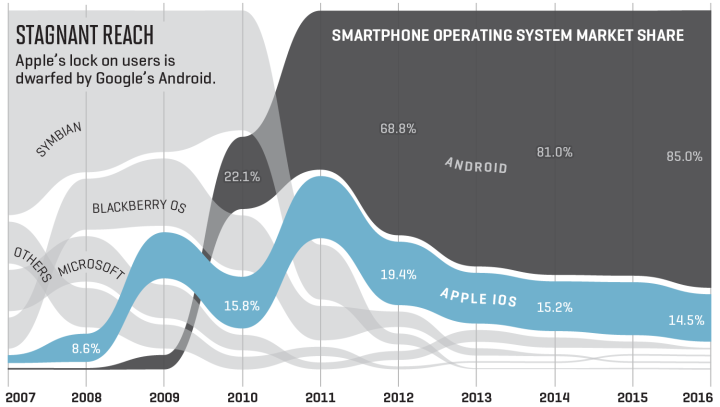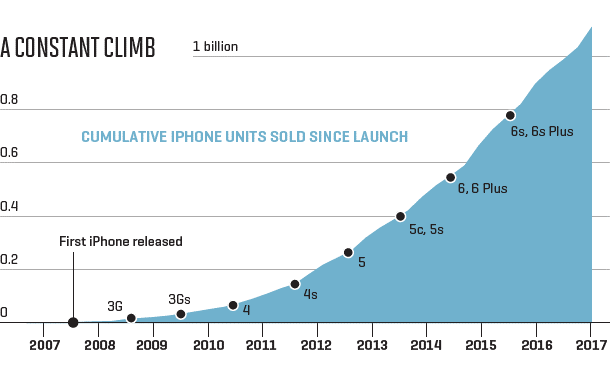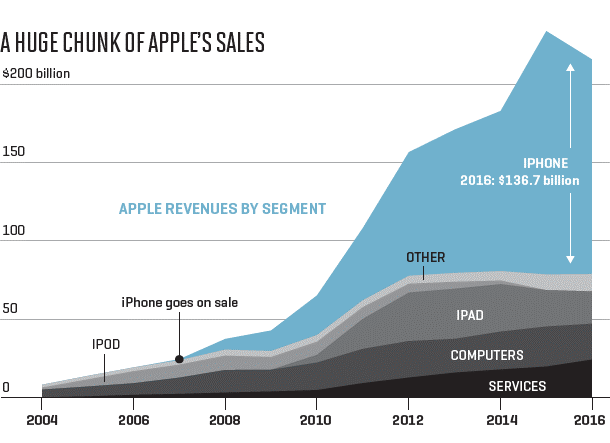回顾iPhone十年

图片提供:Nicolas Rapp
|
谁能想到,革新手机产业并最终引领一代文化的iPhone,最初设计的原因竟是厌恶。苹果公司前首席执行官史蒂夫·乔布斯考虑设计iPhone时发现,大部分人都很讨厌自己的手机。 “每个人都有手机,但我没发现有谁真心喜欢手机,”乔布斯曾对皮克斯动画首席创意官约翰·拉塞特说。 为了设计出人们真心会喜欢的手机,乔布斯做出了大胆创新:触摸屏。大屏幕呈现是实现掌中设备多功能的关键:一会儿可以用来打电话,一会儿可以拍照,再过会又能玩游戏。 |
The design for the device that would revolutionize mobile phones and, eventually, the culture at large, arose from hatred. When considering whether to create the iPhone, Apple CEO Steve Jobs found that people largely despised the phones that they had. “Everybody has a cell phone, but I don’t know one person who likes their cell phone,” he once told John Lasseter, Pixar’s chief creative officer. To create a phone people would actually love, Jobs latched onto an important innovation: the touch screen. The display was the key to creating a computing chameleon: a device that could be a phone one minute, a camera the next, and a gaming pad the next. |

原始iPhone与iPhone 7的区别| 图片提供:Nicolas Rapp
|
2007年1月,主持大师乔布斯向世人推介iPhone,宣传语写得极妙。“今天,我们要推出三件革新性产品,”刚开始乔布斯有意误导大众,后来才解释称因为iPhone结合了三种功能:手机、iPod和网络设备。微软首席执行官史蒂夫·鲍尔默笑了。曾介绍“创造性毁灭”概念的哈佛商学院教授克莱顿·克里斯滕森挠了挠头。但随后1月29日iPhone正式推出时,公众没有半点质疑。十年后,很显然当时批评iPhone的人都错了,用户是对的。 一开始iPhone销售就很好,等到苹果推出第二代型号iPhone 3G,调低价格到199美元并增加无线网络合约版,销量更是激增。 更重要的是,一年后苹果推出了乔布斯先前拒绝的功能:应用商店App Store。通过应用商店用户可以购买并安装第三方开发的移动应用,由此推动了大规模创新,也解锁了崭新的商业模式。 |
The master showman unveiled his smartphone in January 2007 with one of the most brilliant sales pitches ever. “Today, we’re introducing three revolutionary products,” Jobs said with a bit of misdirection, as the iPhone would be all three: phone, iPod, and Internet device. Steve Ballmer, then Microsoft’s CEO, laughed. Clayton Christensen, the Harvard business professor who turned the world on to the notion of “creative destruction,” scratched his head. But the public’s reaction after the iPhone’s release on June 29 was anything but skeptical. Ten years later, it’s clear that the critics were wrong. Consumers were right. Again. Sales started briskly and then went into overdrive after Apple cut the starting price of its second model, the iPhone 3G, to $199 with a wireless contract. More important, one year in, Apple introduced a critical new feature that Jobs had initially resisted: the App Store. It enabled iPhone users to buy and install mobile programs from third-party developers directly to their phones, unleashing a wave of creativity and new business models. |

iPhone十年来的价格变化 | 图片提供:Nicolas Rapp
|
长期跟踪行业的伯恩斯坦研究公司分析师托尼·萨科纳吉表示,iPhone的魅力在于实现了“口袋便携电脑”,而且使用体验非常好。 有iPhone相助,移动通讯在WhatsApp和Snapchat等应用的助推下从宅人小众口味变成一种文化现象。社交巨头推特和Facebook也借机推向巨大的新市场。愤怒的小鸟之类游戏赚得盆满钵满,优步之类共享汽车平台也一夜成名。 iPhone出现早期,苹果抢占的是传统手机的蛋糕。据互联网数据中心(IDC)统计,到2009年底iPhone已经占全世界手机销量七分之一。但随着苹果大肆攻占黑莓、诺基亚和微软的地盘,谷歌也跟随iPhone脚步开始加紧研发手机,并推出了移动操作系统安卓。 谷歌赌对了。 跟苹果的路子不一样,谷歌召集了多家影响力更大资金也更充足的手机运营商。谷歌还与三星等多家硬件厂商合作,研发出更精良的安卓手机,设计样式也更繁多。 |
The magic of the iPhone was putting “the power of a computer in one’s pocket” and then making it easy to use, says longtime analyst Toni Sacconaghi at Bernstein Research. With help from the iPhone, mobile messaging grew from a nerdy niche to a cultural phenomenon with WhatsApp and Snapchat. Social networks Twitter and Facebook gained big new markets. Games like Angry Birds minted money while ride-sharing app Uber burst onto the scene. During the iPhone’s early years, Apple ate the cell phone industry’s lunch. By the end of 2009, iPhones accounted for one of every seven smartphones sold worldwide, according to IDC. But as Apple lapped BlackBerry, Nokia, and Microsoft, Google started its own push into mobile phones that was inspired by the iPhone and introduced mobile operating system Android. The gamble paid off. Unlike Apple, Google courted multiple phone carriers with promises of greater influence and more money. Google also worked with multiple hardware makers including Samsung, leading to better Android phones and a greater variety of designs. |

iPhone的累积销量| 图片提供:Nicolas Rapp
|
到2010年,搭载安卓手机的设备已经超过运行iOS系统的iPhone。三星的大屏幕手机一直为安卓系统产生收益,但苹果没能及时意识到竞争对手的强大。到去年,谷歌安卓系统已经占据市面上六分之五的智能手机。 苹果自己也遭遇不少风波,例如2010年的“天线门”,当时很多用户反馈天线问题但起初乔布斯置之不理。但即便安卓很成功,iPhone销量也一路攀升。2010年苹果iPhone销量较前一年几乎翻倍,2011年再次翻倍,之后保持年均25%的增速,一直到2015年达到峰值,销量近2.32亿部。 |
By 2010, more Android-based phones were being sold than those running the iPhone’s iOS system. Spurring further gains for Android, Apple didn’t quickly recognize the appeal of Samsung’s large-screen phones. By last year, the Google—supplied software powered more than five out of six smartphones. There were other hiccups for Apple, like “Antennagate” in 2010, when Jobs dismissed customer complaints about reception problems with the iPhone. But even with Android’s success, iPhone sales kept climbing. Apple sold almost twice as many iPhones in 2010 than in the year prior, doubled sales again in 2011, and kept growing an average of 25% annually to a peak of nearly 232 million in 2015. |

iPhone的销量收入对苹果越来越重要| 图片提供:Nicolas Rapp
|
然而近来iPhone销量增长还是停滞了。连续两年推出小修小补版本新手机后,2016年苹果售出2.15亿部iPhone,也是首次年度下降。另外,苹果决定不一味迎合大批中国新贵的需求,也影响了部分销量。 现在关于最新款iPhone的谣言甚嚣尘上,据说iPhone十周年之际会推出更大更亮的无边框屏幕;双面玻璃;以及无线充电功能。或许又到了怀念乔布斯最心爱手机的时候了。(财富中文网) 图表数据来源:彭博;战略分析公司;苹果报表 译者:Pessy 审校:夏林 本文另一版本将刊登于2017年6月1日出版的《财富》杂志 |
Still, more recently, the iPhone’s growth has stalled. Apple sold 215 million phones in 2016, its first annual decline, after making only minor tweaks over the previous two years. Sales have also been held back by Apple’s decision not to chase a crop of cheaper Chinese upstarts. The rumor mill is already churning about the next possible iPhone, a 10th-anniversary edition with a bigger, brighter edge-to-edge screen; glass casing; and wireless charging. Maybe it will be enough to put Jobs’ beloved phone back on top. Graphics Sources: Bloomberg; Strategy Analytics; Apple Filings A version of this article appears in the June 1, 2017 issue of Fortune. |











